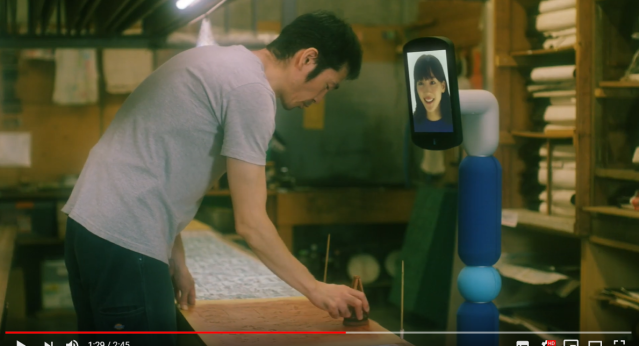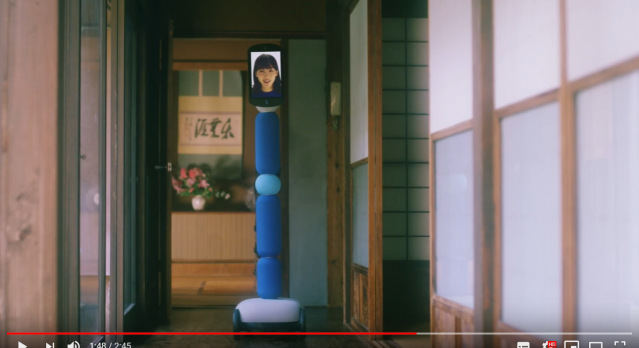
The technology is definitely there, but are your elderly relatives ready for you to drive robots around their houses?
As one of Japan’s two largest airlines, ANA is all about helping people get to different parts of the world. Its newest initiative, though, is creating a system to help you feel like you’re somewhere else without ever leaving home.
Earlier this week, the company released a promotional video for newme, a robot that works with its avatarin communication system. Consisting of a shaft connecting a motorized base and pivoting 10.1-inch display, newme is equipped with a camera, microphone, and speakers that allow the user, who controls it remotely, to look around and communicate with people in the robot’s environment.
Theoretically, it’s all pretty feasible applications of current technology. Seeing it in action in ANA’s video, though, is surreal.
As things start off, our presenter is looking at a map showing the location of newme robots she can hop into. “Oh, an aquarium! Sounds fun,” she says, and with a tap of her finger the aquarium’s newme fires up, showing her face on its display.
Moved by the serene beauty of the underwater world, the woman swings the newme’s camera back and forth to take it all in. Once she’s had her fill, she brings up the map again, and this time hops into a newme that rolls into a kimono and fabric shop she’d been wanting to visit.
“All of our products are individually hand-dyed by their artisans,” the clerk says, with the newme’s audio/video system relaying the conversation in real-time. After the woman asks the clerk to hold the cloth closer to the camera for a better look, the clerk asks if she’d like to speak with the craftsman, and then it’s off to a newme in his rural workshop, where he demonstrates and explains his traditional production process.
However, the woman isn’t only interested in entertaining herself. “I wonder how Grandma is doing these days?” she asks herself, and to get the answer, she makes one last newme jaunt, jumping into a robot we see wheeling through her grandmother’s home.
“I wonder if she’s over here?” the woman’s voice says through the newme’s speakers before encountering the elderly woman in her living room. She then gets up and strolls into the kitchen with the robot, before sitting down for her midday meal and saying “This is just so nice, being able to talk with each other while eating,” Granny says, flashing a radiant smile at her granddaughter’s face on the display.
But while those all seem like things that, from a technical standpoint, shouldn’t be too hard, it still leaves us with a lot of questions. For example, does the aquarium have an entire fleet of robots being remotely driven around the facility, and if so, is anyone making sure they’re not crashing into the actual human guests, or are they just trusting that whoever decides to log into one of them is a skilled and attentive enough pilot to avoid collisions?
That goes ditto for the fabric store. Are they really OK with letting people cruise robots around the shop, with unfeeling motorized wheels and an angle-adjusting robot head potentially snagging cloths and toppling displays of their elegant, and ostensibly expensive, hand-crafted wares?
There’s also the question of how the newme is a better option for the aquarium, store, and craftsman to serve their customers than basic livestream cameras and video chat programs. The intended advantage is clearly supposed to be making it feel more like the user is actually there, promoting a more natural, human feeling in the conversations. By that logic, it seems like it’d actually be a good fit for the video’s last scenario: visiting relatives who live far away, but let’s take one more look at that part.
Notice how the robot pops out on its own, with the woman using it shouting “Grandma!” and instigating a mobilized search for the home’s occupant. When it does roll into the room where Grandma is, she’s surprised to see the machine, asking “Oh? What brings you here?” It’s clear that the granddaughter was able to power up the robot and get it moving (and sending video of the home) entirely from her end of the system, without needing Grandma to authorize any of the process. Granted, maybe the older woman willingly set up access privileges to allow her granddaughter to do that whenever she likes, but still, it seems like the potential stress of robots suddenly roaming your house and shouting would be extremely bad for your heart, especially if you’re of Grandma’s advanced age.
In fairness, it is kind of sweet to see the woman going for a short walk with her granddaughter’s robo-substitute, and that might actually be showing a legitimate benefit of the system. Rather than using the robot to let customers remotely visit leisure and shopping facilities, it might be more effective to have employees pilot the newme in order to guide guests remotely. It could be especially useful for internationally minded companies like ANA who might not have an attendant who speaks a customer’s language physically present in the building, but do have a multilingual team at a central location who could use the newme to lead them to where they need to go in an airport, sports stadium, or event venue.
ANA hopes to start field testing newme in office buildings, department stores, train stations, and real estate agencies soon, and to have 1,000 units in service by the end of next year.
Source: YouTube/ANA Global Channel via IT Media
Images: YouTube/ANA Global Channel
● Want to hear about SoraNews24’s latest articles as soon as they’re published? Follow us on Facebook and Twitter!





 YouTube channel starring 71-year-old Korean grandma is a big hit 【Video】
YouTube channel starring 71-year-old Korean grandma is a big hit 【Video】 ANA unveils robot avatar shopper at boutique in Oita
ANA unveils robot avatar shopper at boutique in Oita Quaint robot ninja virtual sightseeing tours to be held in Kochi Prefecture
Quaint robot ninja virtual sightseeing tours to be held in Kochi Prefecture Chinese woman’s two-pronged money-saving plan: Eat her grandson’s pet for dinner
Chinese woman’s two-pronged money-saving plan: Eat her grandson’s pet for dinner Real-life pilotable anime-style robots now on sale in Japan【Video】
Real-life pilotable anime-style robots now on sale in Japan【Video】 Foreigner’s request for help in Tokyo makes us sad for the state of society
Foreigner’s request for help in Tokyo makes us sad for the state of society Seaside scenery, history, and so many desserts on Yokohama’s Akai Kutsu【Japan Loop Buses】
Seaside scenery, history, and so many desserts on Yokohama’s Akai Kutsu【Japan Loop Buses】 Japanese city loses residents’ personal data, which was on paper being transported on a windy day
Japanese city loses residents’ personal data, which was on paper being transported on a windy day Should you add tartar sauce to Japanese curry rice? CoCo Ichi makes diners an unusual offer
Should you add tartar sauce to Japanese curry rice? CoCo Ichi makes diners an unusual offer Akihabara pop-up shop sells goods made by Japanese prison inmates
Akihabara pop-up shop sells goods made by Japanese prison inmates Mt. Koya planning to instate visitor’s tax to cope with huge tourist numbers
Mt. Koya planning to instate visitor’s tax to cope with huge tourist numbers Ghibli Park now selling “Grilled Frogs” from food cart in Valley of Witches
Ghibli Park now selling “Grilled Frogs” from food cart in Valley of Witches Japanese company uses “crow language” to keep them away from garbage 【Video】
Japanese company uses “crow language” to keep them away from garbage 【Video】 The picture-perfect cosplayers of Comiket 100’s Day 1【Photos】
The picture-perfect cosplayers of Comiket 100’s Day 1【Photos】 New Totoro, Catbus, and other Ghibli plushies transform from cushions to blankets【Photos】
New Totoro, Catbus, and other Ghibli plushies transform from cushions to blankets【Photos】 McDonald’s new Happy Meals offer up cute and practical Sanrio lifestyle goods
McDonald’s new Happy Meals offer up cute and practical Sanrio lifestyle goods Japanese ramen restaurants under pressure from new yen banknotes
Japanese ramen restaurants under pressure from new yen banknotes French Fries Bread in Tokyo’s Shibuya becomes a hit on social media
French Fries Bread in Tokyo’s Shibuya becomes a hit on social media Studio Ghibli releases new action figures featuring Nausicaä of the Valley of the Wind characters
Studio Ghibli releases new action figures featuring Nausicaä of the Valley of the Wind characters Red light district sushi restaurant in Tokyo shows us just how wrong we were about it
Red light district sushi restaurant in Tokyo shows us just how wrong we were about it New private rooms on Tokaido Shinkansen change the way we travel from Tokyo to Kyoto
New private rooms on Tokaido Shinkansen change the way we travel from Tokyo to Kyoto Tokyo Tsukiji fish market site to be redeveloped with 50,000-seat stadium, hotel, shopping center
Tokyo Tsukiji fish market site to be redeveloped with 50,000-seat stadium, hotel, shopping center Beautiful Ghibli sealing wax kits let you create accessories and elegant letter decorations【Pics】
Beautiful Ghibli sealing wax kits let you create accessories and elegant letter decorations【Pics】 Studio Ghibli releases Kiki’s Delivery Service chocolate cake pouches in Japan
Studio Ghibli releases Kiki’s Delivery Service chocolate cake pouches in Japan New definition of “Japanese whiskey” goes into effect to prevent fakes from fooling overseas buyers
New definition of “Japanese whiskey” goes into effect to prevent fakes from fooling overseas buyers Our Japanese reporter visits Costco in the U.S., finds super American and very Japanese things
Our Japanese reporter visits Costco in the U.S., finds super American and very Japanese things All-you-can-drink Starbucks and amazing views part of Tokyo’s new 170 meter-high sky lounge
All-you-can-drink Starbucks and amazing views part of Tokyo’s new 170 meter-high sky lounge More foreign tourists than ever before in history visited Japan last month
More foreign tourists than ever before in history visited Japan last month New Pokémon cakes let you eat your way through Pikachu and all the Eevee evolutions
New Pokémon cakes let you eat your way through Pikachu and all the Eevee evolutions Disney princesses get official manga makeovers for Manga Princess Cafe opening in Tokyo
Disney princesses get official manga makeovers for Manga Princess Cafe opening in Tokyo Sales of Japan’s most convenient train ticket/shopping payment cards suspended indefinitely
Sales of Japan’s most convenient train ticket/shopping payment cards suspended indefinitely Sold-out Studio Ghibli desktop humidifiers are back so Totoro can help you through the dry season
Sold-out Studio Ghibli desktop humidifiers are back so Totoro can help you through the dry season Japanese government to make first change to romanization spelling rules since the 1950s
Japanese government to make first change to romanization spelling rules since the 1950s Ghibli founders Toshio Suzuki and Hayao Miyazaki contribute to Japanese whisky Totoro label design
Ghibli founders Toshio Suzuki and Hayao Miyazaki contribute to Japanese whisky Totoro label design Doraemon found buried at sea as scene from 1993 anime becomes real life【Photos】
Doraemon found buried at sea as scene from 1993 anime becomes real life【Photos】 Tokyo’s most famous Starbucks is closed
Tokyo’s most famous Starbucks is closed One Piece characters’ nationalities revealed, but fans have mixed opinions
One Piece characters’ nationalities revealed, but fans have mixed opinions We asked a Uniqlo employee what four things we should buy and their suggestions didn’t disappoint
We asked a Uniqlo employee what four things we should buy and their suggestions didn’t disappoint Princesses, fruits, and blacksmiths: Study reveals the 30 most unusual family names in Japan
Princesses, fruits, and blacksmiths: Study reveals the 30 most unusual family names in Japan Convenience store robot pilots wanted, wages start at 1,450 yen per hour
Convenience store robot pilots wanted, wages start at 1,450 yen per hour Amazing ad from Japan stars 72 actresses each showing one year of a woman’s life in one second
Amazing ad from Japan stars 72 actresses each showing one year of a woman’s life in one second Meet the Japanese woman in charge of Tokyo’s famous Robot Restaurant in Shinjuku 【Video】
Meet the Japanese woman in charge of Tokyo’s famous Robot Restaurant in Shinjuku 【Video】 Geminoid F: Japan’s android actress with a starring role in a new film 【Video】
Geminoid F: Japan’s android actress with a starring role in a new film 【Video】 Live with a 3-D virtual servant inside your home with Gatebox, now available for pre-order【Video】
Live with a 3-D virtual servant inside your home with Gatebox, now available for pre-order【Video】 Giant pilotable robot appears at Japan Mobility Show, stirs our mecha-loving souls【Pics, vids】
Giant pilotable robot appears at Japan Mobility Show, stirs our mecha-loving souls【Pics, vids】 Japan Railways wants to build a team of robots to help travelers, catch criminals in its stations
Japan Railways wants to build a team of robots to help travelers, catch criminals in its stations 93-year-old Japanese grandma becomes Instagram smash by modelling granddaughter’s creations
93-year-old Japanese grandma becomes Instagram smash by modelling granddaughter’s creations Blink and you’ll miss what riled racists in this Japanese McDonald’s ad 【Video】
Blink and you’ll miss what riled racists in this Japanese McDonald’s ad 【Video】 R2-D2 jet takes to the skies in the most dramatic airline commercial we’ve seen all year
R2-D2 jet takes to the skies in the most dramatic airline commercial we’ve seen all year You can drive this car with a PlayStation controller, meaning Gran Turismo is now real【Video】
You can drive this car with a PlayStation controller, meaning Gran Turismo is now real【Video】 Hello Kitty’s hilariously meta YouTube debut is a hit with netizens, earns likes and subscribers
Hello Kitty’s hilariously meta YouTube debut is a hit with netizens, earns likes and subscribers Woman in Japan “can’t forgive” Starbucks after their hand sanitiser left her with chemical burns
Woman in Japan “can’t forgive” Starbucks after their hand sanitiser left her with chemical burns Premium Cocorobo will clean your floor, wake you up, and probably creep out your friends
Premium Cocorobo will clean your floor, wake you up, and probably creep out your friends You can take this 33,000-pound robot for a virtual test drive, watch it dance to J-pop 【Video】
You can take this 33,000-pound robot for a virtual test drive, watch it dance to J-pop 【Video】
Leave a Reply